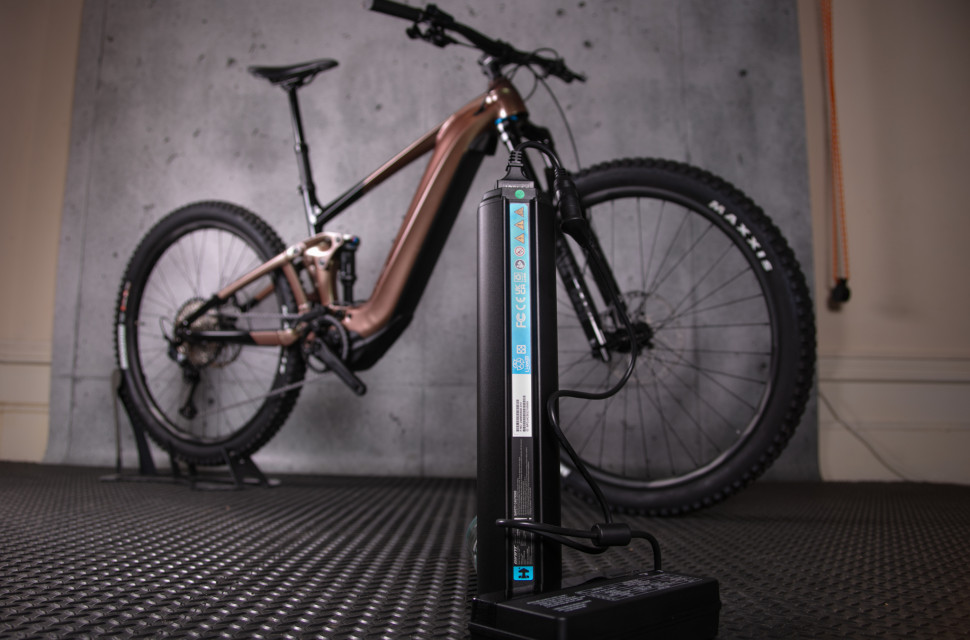How to store an e-MTB - storage solutions and best practices

[Sponsored by Giant Bicycles]
Storing your e-MTB might sound like a rather trivial exercise but because there’s a battery, motor, display and a whole heap of wiring connecting everything, doing things the right way will avoid harming its service life. In this article, with the help of Giant, we will explore the best storing solutions for your e-mountain bike to ensure it stays in fine fettle.
- Welcome to Electric Week - a celebration of the e-MTB
- The anatomy of an e-bike
- How much do e-bikes cost to maintain long-term?
Why correct storage of your e-MTB is important
Just like regular mountain bikes, correct storage practices make for a longer-lasting product. However, as e-mountain bikes rely on batteries for power, storing your e-MTB in the right way is even more important.
Simply slinging a dirty and drained e-mountain bike into a dingy old shed will guarantee the reduction of its potential range and that’s not just the battery we’re talking about. Moisture from the wet mud clinging onto your bike will cause lasting damage to the drivetrain and any excess moisture from where the bike is stored can damage the vital contact points between the motor, battery and display.
Batteries also discharge over time and, if left for too long, it can cause permanent damage and significantly reduce the lifespan and potential range.
Clean your e-MTB regularly
It’s a best practice to thoroughly clean your e-mountain bike after every ride. Leaving your bike covered in mud isn’t the best idea and there may be contaminants such as oil and salt if you’ve ridden on the road that can cause corrosion. Cleaning your bike also allows you to inspect it for excess wear and damage to the frame and components.
You’ll also need to clean the drivetrain, ridding it of any muck and relubricating it with fresh chain lube. Leaving a chain dirty can lead to premature wear and affect the longevity of your drivetrain.
Once clean, your bike will need to be dried thoroughly. There are lots of electrical components on an e-MTB so keeping any contact points free from moisture will prevent corrosion and the a rather costly repair bill at the least.
Before storing your e-MTB, charging the battery will help keep it healthy. If you’re planning on storing it for a long period, keeping the battery level at around 50-80% and recharging when necessary will keep it in the best nick.
How to store your e-MTB
When storing your e-MTB, it’s important to keep it in a cool and dry location. Again, as there is a lot of electrical gubbins going on inside, so reducing moisture will keep corrosion from becoming a factor.
As for how to store it, there are several ways in which it can be kept. It can be leaned up against a wall and even hooked by the front wheel so it’s standing on its rear wheel – the Clug Pro bike rack is a good choice here. Just don’t hang it off of the floor. Doing so over a long period can damage the bike’s components owing to its weight.
Of course, most e-mountain bikes are fairly heavy so store yours in a way that won’t cause injury or be difficult to navigate.
Storing your e-MTB’s battery
Your e-bike battery is the bike’s heart. Without it, your bike won’t be doing the ‘e’ thing for much longer. They can be very expensive to replace, too, so looking after an e-bike’s battery will pay back with an increased service life and range.
However, the lithium-ion batteries in modern e-mountain bikes are rather hardy things. Of course, they are sensitive to temperature fluctuations but there’s a lot you can get away with. Giant states that storing your battery at room temperature is best practice to keep your battery healthy but that’s not always straightforward.
Many might store their e-mountain bikes in places that are susceptible to cold. If that’s the case, disconnecting the battery and storing it inside is a great shout.
As for charging, it’s best to carry this out at room temperature owing to the gel inside the battery that stores voltage. Charging when the battery is cold will limit the voltage it can store – thus limiting your potential range due to the cold stiffening up that gel. If you’ve just experienced a cold snap and your battery has got particularly cold, bring it inside to acclimatise before charging for the best possible range.
What if I can’t remove the battery?
If you have a bike with a fixed battery, the best advice is to keep it in a dry place at room temperature. Unfortunately, there’s not much you can do to keep the battery within the optimal temperature window without good ambient temperature. Wrapping the downtube with insulation won’t do much to help.
However, this is something important to consider when buying an e-mountain bike.
How to keep the battery healthy during a normal riding schedule
If you’re riding weekend in, weekend out or taking full advantage of summer and riding frequently there’s one thing you can do to keep your battery in good nick – run the battery to under 10 per cent every now and then.
E-bike batteries have a memory, so if you’re only using 10 or so per cent of its total capacity and then recharging and repeating this process, it can lower the overall capacity and range. Thankfully, a battery’s memory is short and going out for a longer ride, using all of the battery capacity you can (90 per cent or more) restore its full capacity and refresh its health. It’s a similar kind of thing that you might do with your mobile phone, tablet or other devices that employ lithium-ion batteries.
To make tracking your battery’s health easy, most motor systems have a companion app that should tell you of your battery’s condition on a scale of zero to 100 per cent. The healthiest batteries should read 100 per cent and you can expect to run into issues, such as reduced capacity and range below 85 per cent. At which, the above method may help return your battery to its former glory, or it’s time for replacement.
e-MTB and battery storage requires a little extra care over long periods
If you’re a seasonal rider whose bike only sees the light of day in the spring or summer, or if your e-bike is a winter workhorse, putting your bike into storage for months on end is where extra care is really needed. That said, with modern lithium-ion batteries, self-discharge is minimal thanks to technology that’s built-in that switches the battery into a rest state when heavily discharged.
This adds a level of protection to a battery under extreme circumstances from over-discharge. But with that said, storing your battery partially charged will fend off self-discharge and keep your battery healthier for longer. Keeping your battery at around 60 per cent charged will prolong its life and Giant’s charging method has a system built in that’ll manage the battery’s charge and discharge throughout storage.
As for the bike itself, as mentioned before, keep it in a clean and dry place using your favourite storage method. If that’s a location you don’t visit frequently, investing in a good lock system is incredibly wise.


















1 comments
I'd no more store an ebike battery in my home than I would store petrol in my home.